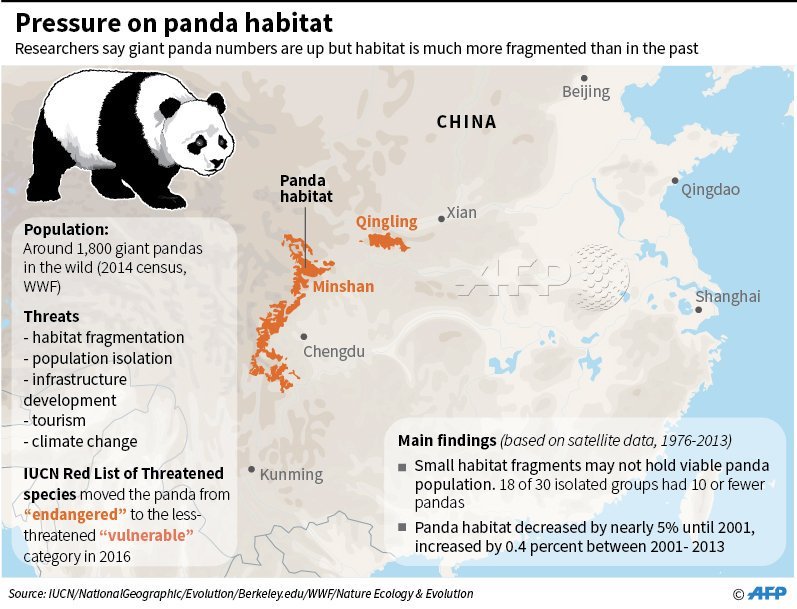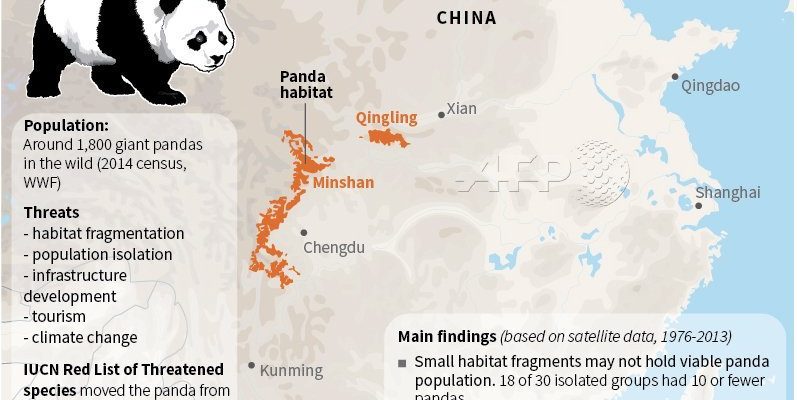
So, let’s dive into the lush landscapes where these gentle giants roam. You might be wondering why their habitat matters so much. Well, these bears rely heavily on bamboo, which is not just a food choice but a vital part of their ecosystem. Let’s explore the intriguing world of giant pandas, their habitat, and the challenges they face in the wild.
The Natural Habitat of Giant Pandas
Giant pandas primarily inhabit the mountainous regions of central China, specifically in Sichuan, Shaanxi, and Gansu provinces. They prefer areas with dense bamboo forests, which provide not only their main food source but also cover to protect them from predators. Think of these forests as giant salad bars, where pandas munch on their favorite greens throughout the day!
These habitats are often found at elevations ranging from 5,000 to 10,000 feet. The cooler, misty climate here is ideal for bamboo growth. The most common bamboo species in their habitats include Moso bamboo, which can grow up to 30 feet tall! Quite impressive, right? In fact, giant pandas can consume up to 30 pounds of bamboo each day, spending roughly 10 to 16 hours eating.
However, here’s the thing: their habitat isn’t just a buffet. It’s also essential for their social interactions and reproductive behaviors. Pandas tend to be solitary animals, coming together mainly for mating. And in these forests, the scent of the bamboo helps them communicate and find mates.
How Habitat Loss Affects Giant Pandas
Sadly, the lush habitats that giant pandas thrive in are under threat. Urban expansion, agriculture, and logging have led to significant habitat loss. When humans encroach on these areas, it not only reduces the space available for pandas but also fragments their living environment. Imagine you’re trying to navigate a busy city with walls blocking your path—pretty challenging, right?
The fragmentation of habitat means that pandas can’t easily move between different areas to find food or mates, which can lead to inbreeding and reduced genetic diversity. Conservationists are working hard to create wildlife corridors to connect these fragmented spaces, allowing pandas to mingle and roam freely.
Another impact of habitat loss is the decline in bamboo availability. Some bamboo species flower and then die off, which can lead to food shortages if pandas are unable to find new sources quickly. This cycle is a significant concern for their survival.
Current Distribution of Giant Pandas
The current distribution of giant pandas is much smaller than it once was. Once roaming across China, pandas are now limited to about 1,864 individual pandas living in the wild. You can often find them in several nature reserves and parks designed to protect their habitat. These include places like the Wolong National Nature Reserve and the Bifengxia Panda Base.
Despite their limited range, these reserves play a crucial role in the conservation of pandas. Here’s a fun fact: the reserves often double as research centers, where scientists study panda behavior and health to improve breeding programs. This helps maintain genetic diversity and ensure a healthy population of pandas.
You might be wondering how these conservation efforts are making a difference. In the past few decades, the giant panda’s conservation status has improved from endangered to vulnerable. While that’s an encouraging sign, there’s still a long road ahead, and maintaining their natural habitat is key.
Climate and Environmental Factors
Giant pandas are also sensitive to environmental changes. They thrive in cool, moist climates, which help support the growth of bamboo. Issues like climate change can alter their habitat, leading to fluctuations in temperature and changes in precipitation patterns. This might seem abstract, but it’s like moving your favorite coffee shop to a place where the coffee beans can’t grow. What happens then? No beans, no coffee!
Rising temperatures can push bamboo to higher elevations, making it harder for pandas to reach their food sources. Conservationists are now tracking these changes and working to create strategies that help pandas adapt to their changing environment. To put it simply, helping pandas survive means understanding their relationship with the climate and acting to protect it.
Conservation Efforts: Protecting Pandas and Their Habitat
In the face of habitat loss and environmental threats, various organizations are stepping up to protect giant pandas and their homes. The World Wildlife Fund (WWF) is one of the leading groups dedicated to crafting policies that benefit panda conservation. Their efforts include habitat restoration projects and community outreach programs that educate locals on the importance of protecting these beautiful bears.
Additionally, breeding programs in captivity have seen success, with many pandas being reintroduced to the wild. This not only helps increase population numbers but also raises awareness of their plight. Many people are drawn to the charm of these animals, and that interest helps fuel conservation funds.
You might be surprised to learn that some of these efforts are supported by tourism. Eco-tourism allows visitors to see pandas in their natural habitats while providing income for conservation projects. It’s like when you share your favorite coffee shop with friends: you help it thrive by bringing in new customers!
Future of Giant Pandas: Hope and Challenges
Looking ahead, the future of giant pandas certainly holds both hope and challenges. As we’ve seen, conservation efforts are making a difference, and increased awareness is helping people understand the importance of protecting these magnificent creatures. However, ongoing habitat destruction and climate change continue to pose significant threats.
Here’s a bright spot: by supporting local organizations and promoting sustainable practices, we can all contribute to panda conservation. Just think of it as investing in a world where these gentle giants can continue to wander their beloved bamboo forests.
Ultimately, the story of giant pandas is entwined with the story of broader environmental health. Protecting their habitats means preserving biodiversity and ecosystems that benefit us all. So, next time you think of giant pandas, remember they’re not just cute animals; they represent a critical piece of the world’s ecological puzzle.
In conclusion, the habitat and distribution of giant pandas are essential aspects of their survival. We’ve explored their natural homes, the challenges they face, and the ongoing efforts to help them thrive. Supporting these efforts means ensuring that future generations can enjoy the sight of a giant panda munching on bamboo in its natural habitat. The journey may be long, but with care and commitment, we can make a difference.

